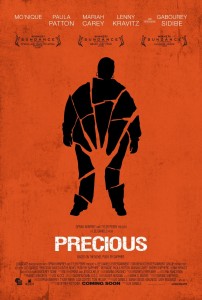Precious was Extra-ordinary
I just watched Precious, Lee Daniel’s film based on the novel Push by Sapphire, and the only way I can find to describe it is extraordinary in the superlative and literal sense. Extraordinary, in the superlative sense, for its craftsmanship in visually and textually telling a narrative of the composite character Precious. It is extra-ordinary (beyond ordinary), in the literal sense, in that it concentrates on a particular set of lives ravished by sexual abuse, physical abuse, and poverty. This is not the tale of all in poverty, but it is a tale that exists. I’m only at the computer writing this because the debate about Precious seems to catapult between a discussion of poverty porn, a Winfrey and Perry produced fetish film to being called a diamond or the Audacity of Precious (a play on Obama’s autobiography). I read the reviews, watched the film and come down somewhere inside and outside of these takes. I did not read the book, I am not a cultural critic, heck I even took a group of friends to see the wrong movie, despite these things I came to Precious open to what it had to offer and enjoyed what I received.

From the moment of the opening credits when the viewer beings to read phonetic words, you are forced inside the life of Precious. I found the narrative was powerfully weaved. The viewer gets to see the compounding hazardous factors that assault Precious on the daily: failing schools, inadequate academic preparation, lack of healthy food options, substandard housing, negotiating the social welfare system, domestic violence, sexual assault, just to name a few. These hazards, for me, fall into two categories, the former are normative of many families mired in poverty and the latter two are often more prevalent in families mired in poverty but are not necessary conditions of poverty. Put another way, the first are features of what it usually means to grow up in a poor neighborhood and household. For the last two, the odds of them occurring are increased by being in poverty but that does not mean they happen in most poor homes. Poverty, like most social forces, has a way of making bad things worse and Precious illustrates this painful circumstance. The movies portraiture of the mid 1980s New York scene is disturbing and rings with a tenor of truth and fantasy. I expect nothing less from a film about urban issues and youth.
The character Precious’ agency, her ability to make independent choices that affect her life, is wonderfully represented in the face of the social maladies she encounters (yes, I know most have an opposite take on this and I’m likely setting myself up for a battle but it’s all good). For those of us who have committed many hours to working with urban Black poor communities, we know that success or transcendence is not always or even often the outcome. You begin to look for the small victories that some would not see as minor, but are nonetheless steps to persevering with the goals of thriving. Our communities are resilient and I think the film captures this and puts context on that resilience. For example, in the movie, the decision to speak up in the welfare office knowing she would compromise her safety, housing, and potentially her life was beyond brave. While sitting in an arm chair and suggesting such a decision is the “obvious” one or one that is “unhelpful” is too narrow a perspective on the faces at the bottom of the well.
I was moved by the film and the story because it represented, in many ways, the lives of the students who I could not touch in New Haven, Atlanta, Detroit and New York. The children who moved, by force and by choice, from the classrooms and schools which I’ve visited, taught in, or spoke at. All too often their agency becomes rendered invisible while their transgressions such as imprisonment, welfare receipt, and deaths are hyper-visible in the public sphere. For this reason, I appreciated the voices and lives the film narrated. There are a number of excellent reviews on what the film missed and some issues that deserve serious consideration. Both The Root and Racialicious do an excellent job of taking these on and I won’t rehash them so please do read them!!! This is not so much a review but rather a reflection and endorsement of stepping out to see the film for yourself. I am excited by the debates and conversations that are erupting for the film and hope they lead us to new ground in transforming communities.



Pingback: uberVU - social comments()
Pingback: Links of Great Interest 11/13/09 | The Hathor Legacy()
Pingback: Uptown Notes - Precious, CNN on Black Men, Mommy Memoirs, and Gay Rights: Addicted to Race()